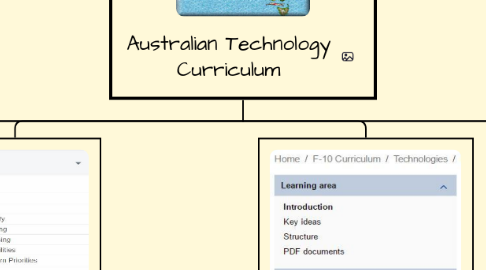
1. :Organisation and structure
1.1. ACARA Band levels
1.1.1. Foundation to Year 2
1.1.2. Years 5 and 6
1.1.3. Years 7 and 8
1.1.4. Years 9 and 10
1.2. Link to other areas
1.3. Content items
1.3.1. knoeledge and understanding
1.3.2. Processes and production skills
1.3.3. Creating solutions by
2. Key terms
2.1. Computational thinking
2.2. Data
2.3. Digital
2.4. Design
2.5. technologies
2.6. play
2.7. multimedia
2.8. engeneering
2.9. Visual programming
2.10. resources
2.11. components
3. Link to other areas
3.1. General capabilities
3.1.1. Literacy
3.1.2. Numeracy
3.1.3. Infomation and communication technology
3.1.4. Creative and critical thinking
3.1.5. Personal and social capability
3.1.6. Ethical understanding
3.1.7. Intercultural understanding
3.2. cross curriculum priorities
3.2.1. Aboriginal and Torres Strait Islander Histories and cultures
3.2.2. Asia and Australia's engagment with Asia
3.2.3. Sustainability
3.3. subjects
3.3.1. English
3.3.2. Mathematics
3.3.3. Science
3.3.4. History
3.3.5. Geography
3.3.6. The arts
3.3.7. Health and Physical education
3.4. STEM: Science, Technology, Engineering and Mathematics
3.4.1. ACARA June 2016 report
3.4.1.1. Engineering in Design and Technologies content
3.4.1.2. Link with subjects
3.4.1.2.1. Science
3.4.1.2.2. Mathematics
3.4.1.2.3. Technologies
3.4.1.3. Link to general capabilities
3.4.1.3.1. numeracy
3.4.1.3.2. Information and communication technology
3.4.1.3.3. critical and creative thinking
3.4.1.4. School wide projects
3.4.1.4.1. sustainability projects
3.4.1.4.2. technology projects
3.4.1.5. Project Aims
3.4.1.5.1. Aim 1: Support students to recognise the importance of knowledge, understanding and skills across STEM subjects
3.4.1.5.2. Aim 2: Improve the confidence of students in STEM and their capacity to transfer knowledge, understanding and skill across subjects and contexts
3.4.1.5.3. Aim 3: Identify explicit connections for students between classroom learning in STEM, and future work and learning opportunities
3.4.1.5.4. Aim 4: Develop strategies that encourage girls to remain engaged in STEM subjects
3.4.1.5.5. Aim 5: Establish guidelines for developing school–industry STEM initiatives
3.4.1.5.6. Aim 6: Enable dialogue about the collaborative development of an integrated STEM program of study or subject.
4. SCASA
4.1. Rational
4.2. Aims and objectives
4.3. Organisation
4.3.1. Achievement standards
4.3.2. Content items
4.3.3. Key ideas
4.3.3.1. Creating preferred futures
4.3.3.2. Project management
4.3.3.3. Thinking in Technologies
4.3.3.3.1. Systems thinking
4.3.3.3.2. Design thinking
4.3.3.3.3. Computational thinking
4.3.3.4. Information and communication technology in the Australian Curriculum
4.3.3.5. Safety
4.3.3.6. Animal Ethics
4.4. Student diversity
4.4.1. Gifted and talented
4.4.2. Students with disabilities
4.4.3. EAL/D
4.5. scope and sequence
5. Content items
5.1. Design and technology
5.1.1. Knowledge and understanding
5.1.1.1. impact on people's lives
5.1.1.2. design concepts
5.1.2. Processes and production skills
5.1.2.1. critique, explore, investigate opportunities
5.1.2.2. generate, develop, evaluate ideas
5.1.2.3. plan, produce and evaluate solutions
5.1.2.4. SCASA creating solutions by:
5.1.2.4.1. Investigating and defining
5.1.2.4.2. Designing
5.1.2.4.3. Producing and implementing
5.1.2.4.4. Evaluating
5.1.2.4.5. Collaborating and managing
5.2. Digital technologies
5.2.1. Knowledge and understanding
5.2.1.1. data representation
5.2.1.2. digital systems
5.2.1.3. impact of people's lives
5.2.2. Process and production skills
5.2.2.1. collect, manage, interpret data
5.2.2.2. use digital systems
5.2.2.3. I.D problems and implement solutions
5.2.2.4. create and communicate infomation
5.2.2.5. SCASA creating solutions by:
5.2.2.5.1. Investigating and defining
5.2.2.5.2. Designing
5.2.2.5.3. Producing and implementing
5.2.2.5.4. Evaluating
5.2.2.5.5. Collaborating and managing
6. ACARA: 2013 draft
6.1. Introduction
6.1.1. Rational
6.1.2. Aims and objectives
6.2. Structure
6.2.1. Band Levels
6.2.2. Content items
6.3. Key ideas
6.3.1. Creating preferred futures
6.3.2. Project management
6.3.3. Thinking in Technologies
6.3.3.1. Systems thinking
6.3.3.2. Design thinking
6.3.3.3. Computational thinking
6.3.4. Information and communication technology in the Australian Curriculum
6.3.5. Safety
6.3.6. Animal Ethics
6.3.7. Achievement standards
6.4. Student diversity
6.4.1. Gifted and talented
6.4.2. Students with disabilities
6.4.3. EAL/D
